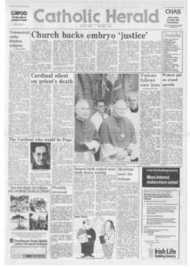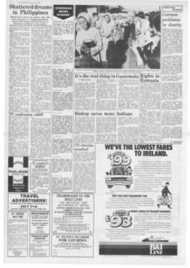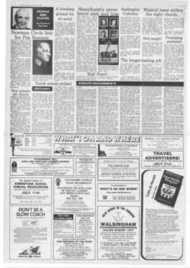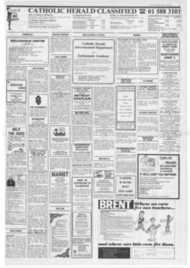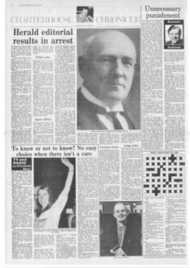Page 5, 10th July 1987
Page 5
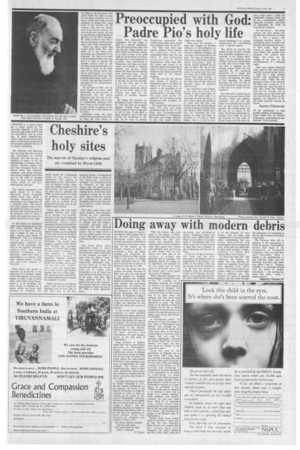
Report an error
Noticed an error on this page?If you've noticed an error in this article please click here to report it.
Tags
Share
Related articles
2 Cheshire Homes For Poland
The Big World Of Little Jeromy
Cheshire, V.c. : The Turning Point Came With The Faith
Letters To The Editor
V.c. Opens Second Home For The Sick
Cheshire's holy sites
The marvels of Cheshire's religious past are examined by Bryan Little
CHESHIRE is a county which has a varied wealth of fine churches. Recently I had the chance to visit some which I had not seen before, and to revisit one, of great magnificence, where I had not previously been aware of the reason lying behind the uniquely splendid feature of its interior furnishing.
My discovery well illustrates the vital point that the structure and furnishings of ancient churches were not put up, or installed in vacuo, or for the entertainment of modern churchtrotters. Historic events, and still more liturgical factors lay behind them, and monastic, collegiate, and parish churches were always designed and fitted out for the kind of worship likely to have been rendered within them in the preReformation centuries.
The church concerned is the parish church of St Mary, Nantwich, whose octagonal central tower rises above a secluded churchyard giving something of the appearance of a cathedral close. The church was long a chapel of ease within the parish of Acton two miles to the west; only with the growth of the attractive town in which it stands did it gain the status of a parish church in its own right.
In this respect its dependent status long resembled that of the still more splendid Bristol church of St Mary Redcliffe, long a chapel of ease in the large, mainly rural parish of Bedminster. This is a building whose architectural magnificence reflected the wealth of the merchants who lived in the parish's urbanised northern half, and whose medieval furnishings, now destroyed, could have been a counterpart, in a church with many chantry priests, of what one can still admire at Nantwich.
What makes the church at Nantwich so distinctive is the splendour of its chancel, rebuilt in the 14th century. It is of rare quality in that it has a lierne vault, with richly carved bosses,. which is of an excellence not often found in England in a church which has never been monastic or collegiate, but which served the worshipping needs of the town's lay population. This chancel, a masterpiece of the "decorated" style of English Gothic, dates from the middle decades of the 14th century. The last years of the same century, probably the 1390s, saw the insertion of what are probably and arguably the finest set of canopied choir stalls, with an excellent set of misericord carvings, seen in any English parish church.
These stalls, with their richly panelled backing and triply spired canopies, were probably inspired by the equally splendid canopied choir stalls at Chester Cathedral. These stalls themselves formed the Model for the modern canopied choir stalls at Downside Abbey. But the stalls at Chester can be explained as they once served the liturgical needs of the monks of the large Benedictine abbey of St Werburgh. The church there became a cathedral when Henry VIII divided the unwieldy diocese of Lichfield and created the new diocese of Chester. No such monastic or collegiate background existed at Nantwich. Another historical explanation must have lain behind the 20 stalls, ten on each side and with their "return" stalls on each side sloping back not in the normal right-angled manner, but at an obtuse angle. This would not have allowed for the solid pulpitum screen normal in monastery churches.
What I now know, as I did not' when I first saw the church at Nantwich over 20 years ago, is that there was, in the late medieval period, a brotherhood of the Holy Cross to which all the important townsmen belonged. This brotherhood had six chaplains, so that these clergy, plus the parish priest, some assistant priests, and some singing clerks, would have been enough to occupy the 20 choir stalls. They could thus explain the furnishirlg of the chancel, altogether more lavish than what one found in a more ordinary parish church.
The stalls, apart from their spiral canopies, with miniature vaulting on their undersides, have splendid misericord carvings whose subjects include St George and the Dragon, wrestlers, wyverns, and a mermaid. The little flanking subjects are also of a grotesque variety. One of them shows a bird not unlike a goose, but with a lion's feet and a rump which comically develops into a human face.
One thing about these admirable stalls is worth noticing. Their misericords, and the delicately vaulted undersides of their canopies, are easier to study than any others I know. The seats, which have the misericords underneath them, are kept lifted up, so that the carvings are readily seen. As the stalls are no longer used liturgically a row of lights has been placed on the floor in front of the seats, with their light rising upwards both to the misericords and to the canopies. This ensures that the study and appreciation of these carvings of the 1390s is made admirably easier.
blog comments powered by Disqus


